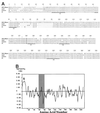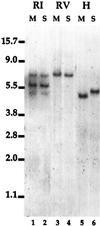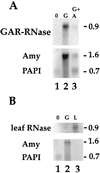Cloning and characterization of a gibberellin-induced RNase expressed in barley aleurone cells
- PMID: 10198105
- PMCID: PMC32031
- DOI: 10.1104/pp.119.4.1457
Cloning and characterization of a gibberellin-induced RNase expressed in barley aleurone cells
Abstract
We cloned a cDNA for a gibberellin-induced ribonuclease (RNase) expressed in barley (Hordeum vulgare) aleurone and the gene for a second barley RNase expressed in leaf tissue. The protein encoded by the cDNA is unique among RNases described to date in that it contains a novel 23-amino acid insert between the C2 and C3 conserved sequences. Expression of the recombinant protein in tobacco (Nicotiana tabacum) suspension-cultured protoplasts gave an active RNase of the expected size, confirming the enzymatic activity of the protein. Analyses of hormone regulation of expression of mRNA for the aleurone RNase revealed that, like the pattern for alpha-amylase, mRNA levels increased in the presence of gibberellic acid, and its antagonist abscisic acid prevented this effect. Quantitative studies at early times demonstrated that cycloheximide treatment of aleurone layers increased mRNA levels 4-fold, whereas a combination of gibberellin plus cycloheximide treatment was required to increase alpha-amylase mRNA levels to the same extent. These results are consistent with loss of repression as an initial effect of gibberellic acid on transcription of those genes, although the regulatory pathways for the two genes may differ.
Figures





Similar articles
-
Gibberellin-repressible gene expression in the barley aleurone layer.Plant Mol Biol. 1996 Feb;30(3):611-23. doi: 10.1007/BF00049335. Plant Mol Biol. 1996. PMID: 8605309
-
Molecular analysis of the barley ( Hordeum vulgare L.) gene encoding the protein kinase PKABA1 capable of suppressing gibberellin action in aleurone layers.Planta. 2002 Jun;215(2):319-26. doi: 10.1007/s00425-002-0740-6. Epub 2002 Mar 9. Planta. 2002. PMID: 12029482
-
Gibberellin-regulated expression of a myb gene in barley aleurone cells: evidence for Myb transactivation of a high-pI alpha-amylase gene promoter.Plant Cell. 1995 Nov;7(11):1879-91. doi: 10.1105/tpc.7.11.1879. Plant Cell. 1995. PMID: 8535141 Free PMC article.
-
Primer extension studies on alpha-amylase mRNAs in barley aleurone. II. Hormonal regulation of expression.Plant Mol Biol. 1991 Apr;16(4):637-45. doi: 10.1007/BF00023428. Plant Mol Biol. 1991. PMID: 1868201
-
Biotechnology of cereals.Biotechnol Genet Eng Rev. 1993;11:79-146. doi: 10.1080/02648725.1993.10647899. Biotechnol Genet Eng Rev. 1993. PMID: 7840849 Review. No abstract available.
Cited by
-
RNase T2 genes from rice and the evolution of secretory ribonucleases in plants.Mol Genet Genomics. 2010 Apr;283(4):381-96. doi: 10.1007/s00438-010-0524-9. Epub 2010 Feb 25. Mol Genet Genomics. 2010. PMID: 20182746
-
Examination of the leaf proteome during flooding stress and the induction of programmed cell death in maize.Proteome Sci. 2014 Jun 11;12:33. doi: 10.1186/1477-5956-12-33. eCollection 2014. Proteome Sci. 2014. PMID: 25028572 Free PMC article.
-
Phloem-specific expression of the wound-inducible ribonuclease LE from tomato (Lycopersicon esculentum cv. Lukullus).Planta. 2004 Jun;219(2):233-42. doi: 10.1007/s00425-004-1227-4. Epub 2004 Mar 3. Planta. 2004. PMID: 14997395
-
Uncovering DELLA-Independent Gibberellin Responses by Characterizing New Tomato procera Mutants.Plant Cell. 2015 Jun;27(6):1579-94. doi: 10.1105/tpc.114.132795. Epub 2015 Jun 2. Plant Cell. 2015. PMID: 26036254 Free PMC article.
-
Suppression of LX ribonuclease in tomato results in a delay of leaf senescence and abscission.Plant Physiol. 2006 Oct;142(2):710-21. doi: 10.1104/pp.106.080135. Epub 2006 Aug 18. Plant Physiol. 2006. PMID: 16920876 Free PMC article.
References
-
- Aubert S, Gout E, Bligny R, Marty-Mazars D, Barrieu F, Alabouvette J, Marty F, Douce R. Ultrastructural and biochemical characterization of autophagy in higher plant cells subjected to carbon deprivation: control by the supply of mitochondria with respiratory substrates. J Cell Biol. 1996;133:1251–1263. - PMC - PubMed
-
- Bariola PA, Howard CJ, Taylor CB, Verburg MT, Jaglan VD, Green PJ. The Arabidopsis ribonuclease gene RNS1 is tightly controlled in response to phosphate limitation. Plant J. 1994;6:673–685. - PubMed
-
- Brown PH, Ho T-HD. Biochemical properties and hormonal regulation of barley nuclease. Eur J Biochem. 1987;168:357–364. - PubMed
Publication types
MeSH terms
Substances
LinkOut - more resources
Full Text Sources
Miscellaneous

